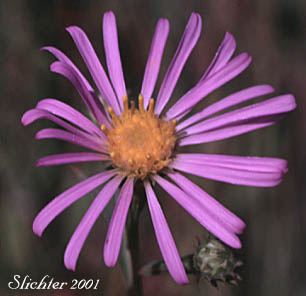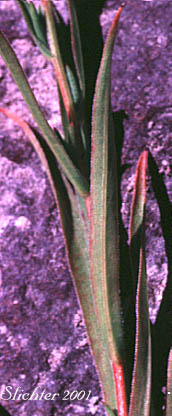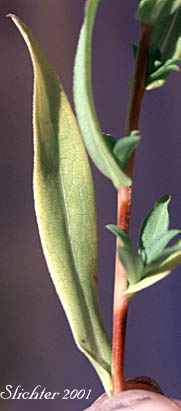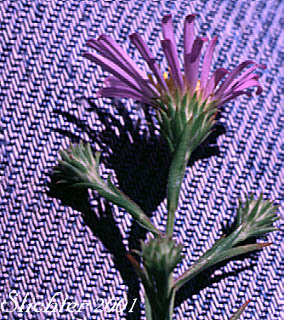[Asters: The Genera Canadanthus, Eucephalus, Eurybia, Seriocarpus and Symphyotrichum in the
Columbia River Gorge of Oregon and Washington]
Larger Western Mountain Aster, Western Aster, Western Mountain Aster
Symphyotrichum spathulatum var. intermedium
Synonyms: Aster occidentalis ssp. occidentalis, Aster occidentalis var. occidentalis, Aster spathulatus var. intermedius

The flower head of Aster occidentalis var. intermedius
as found at the mouth of the Deschutes River.........September 3, 2000.
 The photo
at right illustrates the mid to upper stem leaves of Aster occidentalis
var. intermedius as found at the mouth of the Deschutes River.........September
3, 2000. Note the narrow leaves.
The photo
at right illustrates the mid to upper stem leaves of Aster occidentalis
var. intermedius as found at the mouth of the Deschutes River.........September
3, 2000. Note the narrow leaves.
Characteristics:
Western aster is an erect perennial wildflower arising 20-100
cm from a creeping rhizome. The herbage is generally smooth or without hairs.
The lower stem leaves are oblanceolate in shape and petiolate, and they tend
to persist into flowering. They may have entire or serrate margins. The middle
and upper leaves are narrower with entire margins and measure from 3-15 cm long
and 3-15 mm wide. The leaves tend to be 7-20 times longer than they are wide.
The inflorescence is a corymb or cymose panicle of one to many
flower heads about 2.5 cm wide. The involucre is 5-7 mm high with obtuse to
acutely tipped bracts. The bracts are green and occasional purple margined.
Individual bracts are narrowly linear or linear-oblong with short hairs along
the margins. The 20-50 rays are about 6-15 mm long and blue, violet or purple
in color.
Variety intermedius is much larger and more branched
than variety occidentalis with more
flower heads arranged in a leafy-bracteate inflorescence.
Habitat:
Western aster may be found in mountain meadows. Variety
intermedius may be found at lower elevations than variety occidentalis.
Range:
Aster occidentalis is found from British Columbia south
through Washington and Oregon to California, and eastward to Idaho and Colorado.
Variety intermedius tends to be found in the eastern
portion of the range of the species in eastern Washington and northern Idaho.
In the Columbia River gorge, variety intermedius may
be found between the elevations of 200'-2000' from Bingen, WA east to
Biggs, OR..

Larger western mountain aster blooming on the cobbly shoreline of Pierce Island, Columbia Land Trust lands in the western Columbia River Gorge.........September 7, 2018.
 -
- 
One of the larger (and wider) stem leaves of
Aster occidentalis var. intermedius as found at the mouth of the
Deschutes River.........September 3, 2000.Note the narrow bracts tapering gradually to a fairly sharp point in the picture at right from the same location.
Paul Slichter




